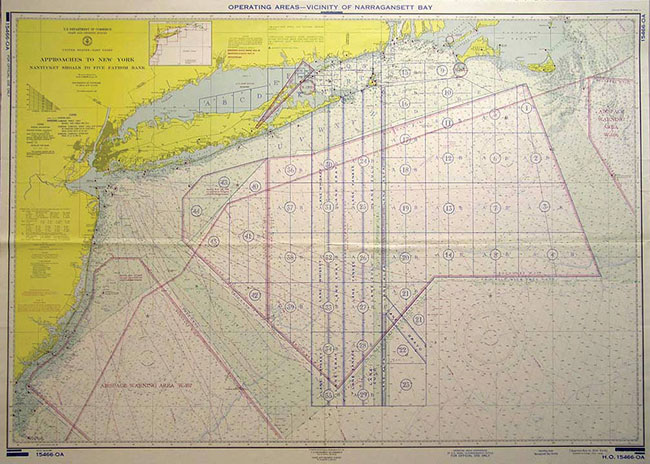Historical Nautical Charts Collection: New York Harbor
Approaches to New York

Figure 7. This nautical chart depicts Long Island and approaches to New York City. The chart was
published in 1944, at the height of World War II and the same year that the battleship USS Missouri was launched from the
New York Naval Shipyard.
(Click the image to enlarge.)
The United States was a nation at war when this nautical chart was published (Figure 7). In response to the times, the chart bears an interesting warning to mariners: "Aids to navigation may be altered, interrupted, or removed without notice. In general, temporary changes due to war conditions are not incorporated on the chart."
Other features of note on this chart include abbreviations for the location of lights, buoys, radio towers, and shipwrecks. The chart also includes a table that lists the names of stations with radio beacon signals and descriptions of how the signals might sound. The location of such signals would have been useful to mariners in navigating the waters around New York City, particularly when weather conditions, such as fog, storms, and low-visibility days made navigating particularly tricky.
Historic Reference
The USS Missouri was a 45,000-ton battleship built and launched at the New York Naval Shipyard (also known as the Brooklyn Navy Yard) in January, 1944—the year this nautical chart was published. The Missouri played a prominent role for the remainder of World War II. Arriving in the Pacific war zone in January of 1945, the Missouri supported the Battles of Iwo Jima and Okinawa and raids on Japan's home islands. On September 2, 1945, the Japanese surrendered abroad the Missouri as she was anchored in Tokyo Bay, marking the end of World War II.
Works Consulted
U.S. Navy, Naval Historical Center. (2000). USS Missouri (BB-63), 1944-1998, Selected Views. Retrieved June 20, 2006, from: http://www.history.navy.mil/photos/sh-usn/usnsh-m/bb63.htm.
